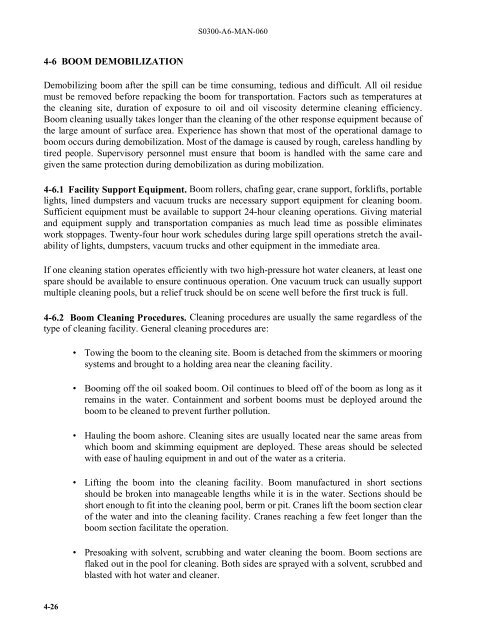U.S. Navy Ship Salvage Manual Volume 6 - Oil Spill Response
U.S. Navy Ship Salvage Manual Volume 6 - Oil Spill Response
U.S. Navy Ship Salvage Manual Volume 6 - Oil Spill Response
- No tags were found...
You also want an ePaper? Increase the reach of your titles
YUMPU automatically turns print PDFs into web optimized ePapers that Google loves.
S0300-A6-MAN-0604-6 BOOM DEMOBILIZATIONDemobilizing boom after the spill can be time consuming, tedious and difficult. All oil residuemust be removed before repacking the boom for transportation. Factors such as temperatures atthe cleaning site, duration of exposure to oil and oil viscosity determine cleaning efficiency.Boom cleaning usually takes longer than the cleaning of the other response equipment because ofthe large amount of surface area. Experience has shown that most of the operational damage toboom occurs during demobilization. Most of the damage is caused by rough, careless handling bytired people. Supervisory personnel must ensure that boom is handled with the same care andgiven the same protection during demobilization as during mobilization.4-6.1 Facility Support Equipment. Boom rollers, chafing gear, crane support, forklifts, portablelights, lined dumpsters and vacuum trucks are necessary support equipment for cleaning boom.Sufficient equipment must be available to support 24-hour cleaning operations. Giving materialand equipment supply and transportation companies as much lead time as possible eliminateswork stoppages. Twenty-four hour work schedules during large spill operations stretch the availabilityof lights, dumpsters, vacuum trucks and other equipment in the immediate area.If one cleaning station operates efficiently with two high-pressure hot water cleaners, at least onespare should be available to ensure continuous operation. One vacuum truck can usually supportmultiple cleaning pools, but a relief truck should be on scene well before the first truck is full.4-6.2 Boom Cleaning Procedures. Cleaning procedures are usually the same regardless of thetype of cleaning facility. General cleaning procedures are:• Towing the boom to the cleaning site. Boom is detached from the skimmers or mooringsystems and brought to a holding area near the cleaning facility.• Booming off the oil soaked boom. <strong>Oil</strong> continues to bleed off of the boom as long as itremains in the water. Containment and sorbent booms must be deployed around theboom to be cleaned to prevent further pollution.• Hauling the boom ashore. Cleaning sites are usually located near the same areas fromwhich boom and skimming equipment are deployed. These areas should be selectedwith ease of hauling equipment in and out of the water as a criteria.• Lifting the boom into the cleaning facility. Boom manufactured in short sectionsshould be broken into manageable lengths while it is in the water. Sections should beshort enough to fit into the cleaning pool, berm or pit. Cranes lift the boom section clearof the water and into the cleaning facility. Cranes reaching a few feet longer than theboom section facilitate the operation.• Presoaking with solvent, scrubbing and water cleaning the boom. Boom sections areflaked out in the pool for cleaning. Both sides are sprayed with a solvent, scrubbed andblasted with hot water and cleaner.4-26
















